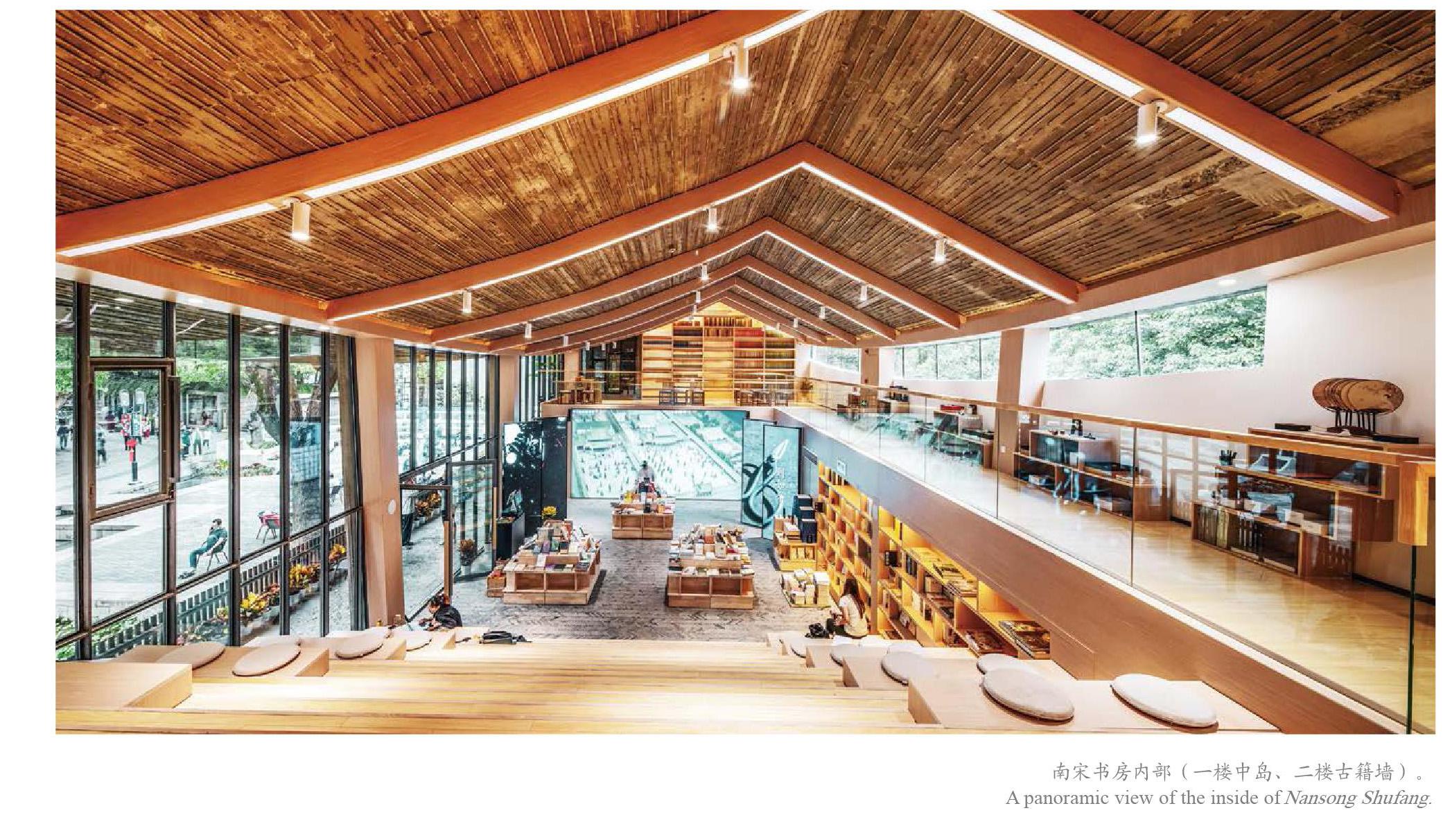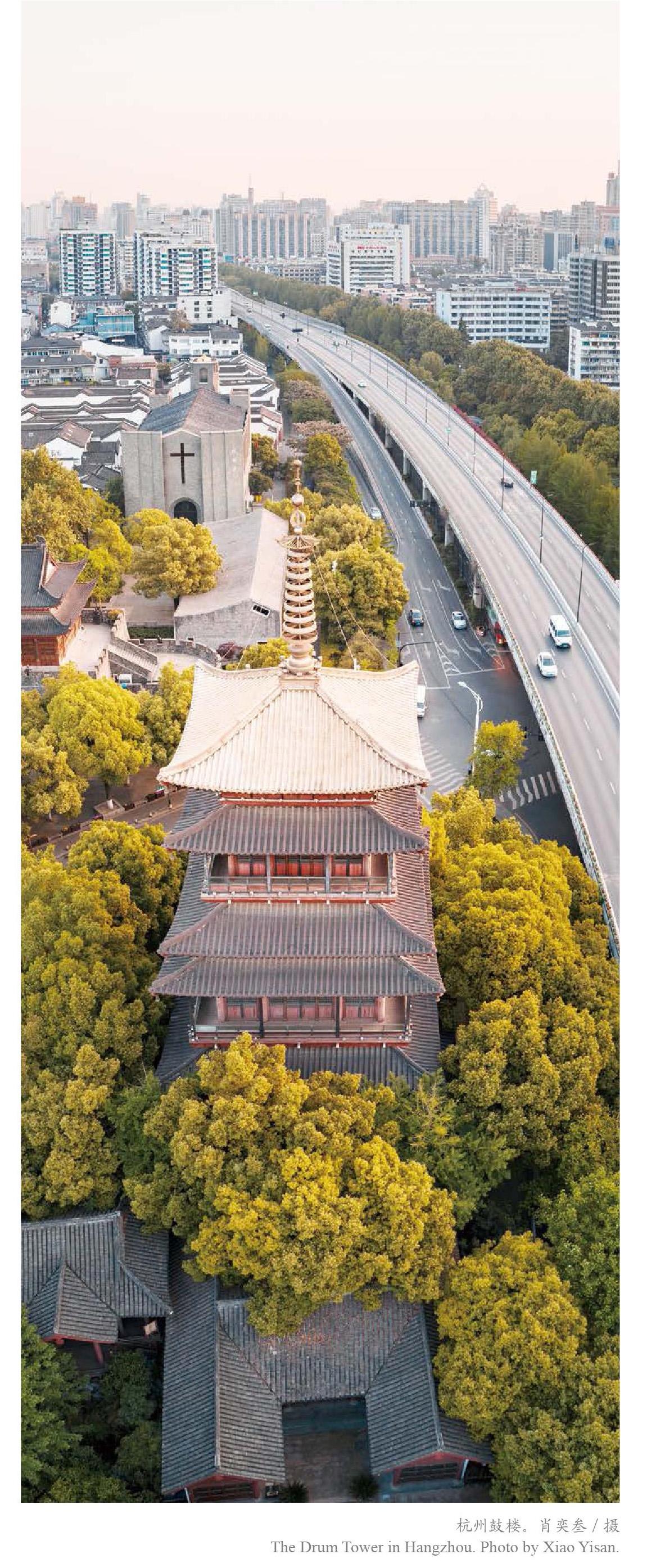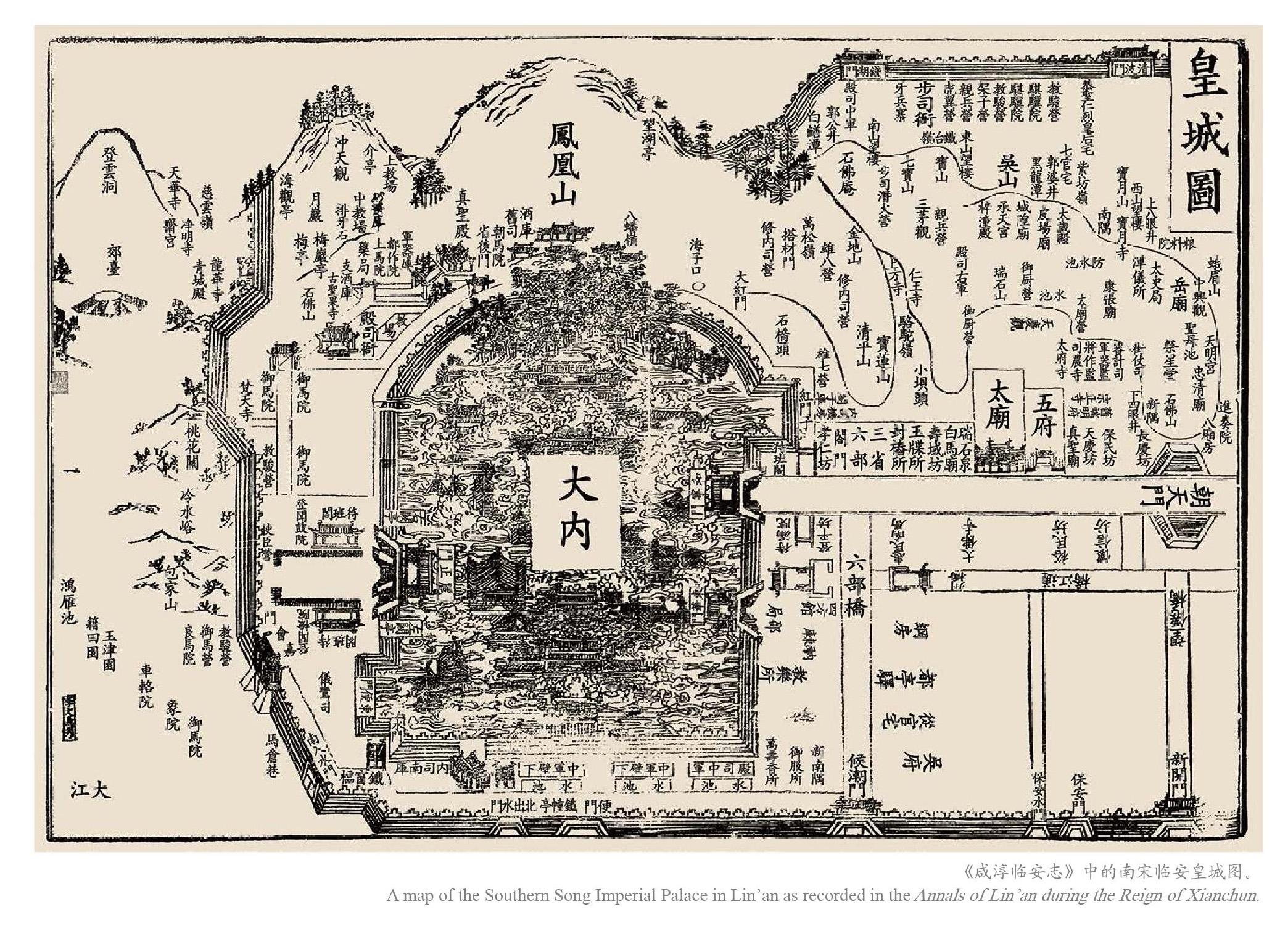皇城脚下:一隅书房 一隅南宋
林蔚然 吴洋



杭州人对南宋非同一般的感情,在生活中随处可见:有一条街叫南宋御街,有一间书店叫南宋书房,有一家糕点叫南宋胡记……这一次,让我们沿着这条南宋曾经的街道,走进这间南宋主题的书房,像宋人一般静心看一本书,品味宋人的文化雅趣,追寻宋人的踪迹,探访南宋高度繁荣的文化特质。
皇城脚下 有街有书
从中山路一路往南,就到了这临安城曾经的中轴线——南宋御街。南宋御街对南宋皇朝和南宋百姓来说都非常重要,它两旁集中了数万家商铺,临安城一半的百姓都住在附近。
南宋御街的盛况,从很多古籍里都能一睹更为详实的风采:
比如《西湖游览志》记载,南宋皇朝时御街是控制全城的主轴线。古时的南宋御街南起皇宫北边的和宁门外,向北经朝天门(今鼓楼)略向西侧,北经众安桥、贯桥,至新庄桥,有长10里之说,又名“十里天街”。它是南宋王皇城达官贵人出行的必经之路,也是一年之中皇帝于“孟春、孟夏、孟秋、孟冬”四孟之际到景灵宫(现今武林路西侧)祭祀时的专用道路。
在当时,南宋御街还是南宋时期的政治中心,集聚了朝廷中枢机关,具有很高的政治地位。所以御街的管理与修缮不比一般道路,是由朝廷命令、临安知府亲自主持的大政。《咸淳临安志》所记载的有关御街的维修,是南宋规模最大的一次修葺,也是最后一次。因为再过八年,元军攻下临安,南宋朝廷就投降了。
南宋灭亡后,又经过数百年的风雨侵蚀,御街逐渐从人们的视野中隐去了,直到2009年重新修复后才开街。重修后的御街长3.7公里,位于杭州主城区,以中山路为主线,南起鼓楼,北接西湖大道。游客纷至沓来,都想走一走那曾经的御道。游览路线一般是从北往南,沿着南宋御街走到尽头,再去一去那承载着厚重杭州城市历史记忆的建筑——鼓楼。出了鼓楼,就又回到了现代的车水马龙。
从御街尽头到鼓楼,即游览御街景区的“最后一公里”,是浓缩了南宋文化精华的鼓楼广场。在这里,一家新开的书店静静地矗立着,名字也与南宋御街十分贴切,一侧墙上低调地写着方方正正的楷体字——“南宋书房”。外观是青砖黑瓦与现代玻璃的结合,古色古香中糅合了现代感,颇有趣味却不失雅致。而内里则不似外观这般低调:有点小曲折的走廊,两边是水纹玻璃式的幕墙,不论昼夜,都能营造出一种光影迷离的效果;墙上还挂了多个介绍南宋人物及诗画的电子屏,摆放的书和瓷器也均与南宋相关。再往里走,豁然开朗,阶梯状的台阶可供读者、参观者休憩看书,巨大的楼梯直通二楼书墙。柔和而温暖的原木色,满足了对书房的所有幻想。这样就可以保证即使在人流量大的情况下,也能让读者有一人一座的空间,不至于太挤。
楼梯里内嵌LED屏幕,自二楼往下看,好似有奇效。沿着台阶站上二楼,从最高处看一楼正中间的一面最大屏和四面小竖屏,正在播放吴山景区、南宋皇城遗址和南宋御街的城市宣传片。二楼有两面书墙,一面近代出版物,一面古籍。长长的走廊通往长桌和雅座,旁边摆放着一些文创。尽头配有茶室,可以惬意地办公。纵深感的设计,时空仿佛也在这里延伸了。小阶梯和露台,让空间既有融合感又有分离感,让读者在公共空间也能有体验到“独处”的美妙。
临安书坊 一脉相承
杭州自古以来就是书坊林立、书香浓郁的城市。在北宋时已有书坊,南渡后私人书铺更多,称为经铺、经坊或称经籍铺、经书铺、书籍铺,可考的有近20家。南宋书房选择在鼓楼边上传承一脉书香,这或许是一种巧合,也或许更像是一种注定。因为从众安桥到鼓楼的这段御街里程,恰恰就是南宋时临安城里书坊最为集中的地带,说是“书市”也不为过。
临安书坊不仅鬻书贩书,还兼顾刻书出版,其中最有名的当属陈宅书籍铺。陈宅书籍铺第一代主人陈起,字宗之,号陈道人,曾举乡贡第一,故又称陈解元。居睦亲坊,因“奉母”而开肆卖书。所以陈宅书籍铺主铺开在睦亲坊巷口,书籍销量极好。另在临安其他处还开有两家分店,经营规模相当可观。
陈起本质上是一个商人,但他曾经中过解元,史载他“能诗”,所以身上多少沾点文人气质。在同行多半热衷于做一些三教九流之书时,陈起却对先贤诗集及金石画册青睐有加。不仅在朝野上交往颇多,陈起与民间诗人也结交甚广,一时间陈宅书铺可谓是“谈笑有鸿儒,往来无白丁”。
除了品位高雅、挑书讲究之外,陈宅书铺能在中国古代出版发行史上有着举足轻重的地位,离不开两宋发展起来的高效精美的刻书技术。陈宅书籍铺所刊书籍世称“书棚本”,受到藏书家的极度珍视,至今仍是少数国家级博物馆的镇馆之宝。宋书的刻印堪称后世的模范,纸质细腻,装帧精致,字迹清晰,用墨考究,对现代的书籍式样的形成都有着很大的影响。
从北宋到南宋,经济、文化、手工业以及商业的高度发展和空前繁荣,反映在书籍出版上的特点和优势就是书多、纸好、技术高。
宋代出书数量之多,远远超过以往历代。据《世界图书》统计:我国从西汉直至五代,共出书两万三千多部,二十七万多卷。而宋代出的书将近历代出书总数的一半。不僅仅是数量大幅度增加,宋代图书出版业的繁荣,还体现在书品类的增多。南宋的著作物遍及当时所有各个知识部门,除却儒释道典籍和诗集词集,还有天文、地理、医药、农业、工业、民间文学以民间日用必需的书籍等。不仅当时的著作多付诸印刷,还有前代人的著作也陆续出版。
宋代的造纸业已经发展到了较高的水平。当时刻印所用的纸张,文理坚韧,细腻平滑,这对后续书籍的印刷,创造了有利条件。由于纸张精美,宋时常常作为贡品,又称“贡纸”。宋代各地进献贡纸的有8处,而唐代进献的只有婺、衢两处。这说明,宋代生产的纸张质好量多,是前代远远不能相提并论的。
雕版印刷术发明于隋末唐初,逐步普及于唐末,迅速发展于两宋。北宋时虽发明了活字印刷术,但在当时并未受到重视。所以南宋的主要印刷技术仍然是雕版印刷,陈起所用也是如此,但刻书、印刷技术日趋纯熟。在北宋时,杭州就是印刷中心,有“监本刊于杭者,殆居大半”之称。至南宋时,雕版工人荟萃于此,刻印了经书、史书、子书、医书、算术以及文集等。浙本字体方正,刀法圆润,雕版技术已经达到相当高的水平。
南宋出版業的繁荣,侧面印证了南宋文化思想的鼎盛,被中外学者称为“东方的文艺复兴”“中国历史上的第二次百家争鸣”。
深入挖掘 开拓创新
2020年9月,鼓楼旁的清河坊街区开放,使得人们对南宋历史文化的发掘再度升温。和改造后的清河坊街区一同亮相的南宋书房,依托得天独厚的地理优势,迅速成为了“网红打卡地”,且热度居高不下。
杭州从来不缺书店,南宋书房却能在众多书店里脱颖而出。诚然,它一定程度上占据了“天时地利”的优势,但更为引人瞩目的其实是“宋韵文化×当代审美”这个主题。正如南宋书房主理人赵群伟在采访中所说的,“主题书房其实在杭州并不多见,到目前为止仅此一家”。
赵群伟介绍,“南宋书房还是一家6.0复合业态主题书店”,集宋韵文化展示、宋韵主题讲座、宋韵文创研发、宋韵主题出版、宋韵主题邮局、新形态传播六种功能于一身。
作为集中展示宋韵文化的公共平台,南宋书房图书品类涵盖宋韵文化的各个方面,还收藏了大量宋韵文化普及类读本及部分历代古籍影印本。据介绍,南宋书房的藏书超过两万册,其中约三分之一的图书与宋韵文化相关。通过对宋韵文化的展示及讲座展开对宋韵文化的深入挖掘,再通过文创、立体书、邮票等多元的方式去开拓创新、去普及,将文化用短视频、直播等融媒体形式“走出去”,这就是南宋书房创立的要义。
南宋书房还以“宋韵+亚运”的双韵(运)概念为契机,重点开发一批叠加了双元素的文创产品。目前正在进行中的有宋代百子图系列文创,极具知识性、互动性和趣味性,主要产品类型包含:盲盒、人形玩偶、邮票、明信片、其他形态等。另外,南宋书房即将开通线上销售平台,线上、线下同步发售各类具有宋韵属性的图书、文创及活动产品。
人来人往,从史料中获得的对当年南宋御街的想象再到眼前真实感受的场景,岁月斑驳了外墙,热闹却不减当年。有些东西一直在变,窗外的沧海早已换了桑田;有些东西万年不变,一城一水,一书一人。
Books, Bookstores and
the Southern Song Imperial Street
By Lin Weiran Wu Yang
Walk along the Zhongshan Road all the way to the south end, and you will reach the Southern Song Imperial Street, once the center of Linan, the capital city of the Southern Song dynasty (1127-1279) and present-day Hangzhou. The importance of the Imperial Street could not be overstated for both the Southern Song court and the common people at that time, for tens of thousands of shops were located around it, and half of the citys population lived nearby.
Indeed, in Xihu Youlan Zhi, or Gazetteer for Sightseeing around the West Lake, the Imperial Street was regarded as the principal axis that could effectively be employed to control the whole city. Starting from Hening Gate of the Imperial Palace to the south, through the Chaotian Gate (currently known as Gulou, or the Drum Tower), via the Zhongan Bridge and the Guanqiao Bridge, before coming to an end at the Xinzhuang Bridge to the north, the Imperial Street stretched for some ten li (or five kilometers), hence its sobriquet Shili Tianjie, or Ten-li Heavenly Street. It was the path that the Southern Song dignitaries must tread on whenever they needed to get around. The street also served as a special imperial passageway when the emperor performed worshipping rituals during the first month of each lunar season, i.e. the first, fourth, seventh and tenth lunar month.
The Imperial Street was the indisputable political center of the Southern Song dynasty, where vital government ministries and organs were concentrated. With such an elevated political status, the street and its management fell under the direct purview of the governor of Linan, the capital city. The Annals of Linan during the Reign of Xianchun recorded the largest renovation ever done for the street in the Southern Song period, which, unfortunately, was also the last, for the dynasty would crumble eight years later.
After the collapse of the Southern Song, the Imperial Street gradually fall into oblivion in the next few hundred years. Until 2009, when it was reopened after extensive reconstruction and repairs. The new Imperial Street, rebuilt along a significant part of the Zhongshan Road, is about 3.7 kilometers long, starting from the Drum Tower in the south and ending at the intersection with the West Lake Avenue.
Since its reopening, tourists from home and abroad have flocked to the street to have a taste of its glorious past, walking from the north to the south before arriving at the Drum Tower, in which much of the citys history has been stored. Outside, history phases into the present, cars and flyovers readily bringing visitors back to reality.
Adjoining the Drum Tower lies a small piece of square, which is aptly named the Drum Tower Square. At one side of the square is a large bookstore, and on its front walls, written in Kai Shu or standard Chinese script, are four characters “Nan”, “Song”, “Shu”, “Fang” (Southern Song Study Room). The name of the bookstore indeed befits what the Imperial Street stands for, as does its exterior, a mixture of blue tiles and glass.
When people walk inside, their attention would only be caught: a short but zigzagging corridor, both sides covered with glass in water ripple patterns, as if forming a curtain, and creating the blurred effect of light and shadow day and night; electronic screens on the walls introducing figures, poems and paintings from the Southern Song dynasty, as well as books and porcelain products related to the period. Further inside, the space suddenly opens up. A flight of broad and giant staircases double as “seats” for readers and visitors — on the sides of each staircase are also embedded LED screens, showing video clips on the Southern Song. The flight leads straight to a book wall on the second floor and the gentle and warm color of wood makes it look like a personal study room.
Since opening in September 2020 along with the neighboring Qinghefang Ancient Street, Nansong Shufang has fast become one of the favorite places for readers and tourists even as the bookstore continues to explore new ways of showcasing the splendor the Song culture.
Bookstores have been a major feature of Hangzhou since times of old, and it was no exception when it came to the Song dynasty (960-1279). While a number of bookshops were already in operation during the Northern Song (960-1127), records show Linan boasted nearly 20 private bookshops in the Southern Song, most of which, coincidentally or otherwise, concentrated near the Drum Tower. Unlike their modern counterparts, these bookshops not only sold books but also printed and published books, and some of the surviving copies that are collected at a few national-level museums are so valuable that they are seen as the museums “most precious treasures”. With their superior papers, elegant bindings, clear handwriting and exquisite inks, Song books served as the model for later generations and had a great influence on the style of modern books. Buttressed by unprecedented development in economy, culture, handicraft industry and commerce, publishing in the Song boomed.
For one thing, the number of books published in the Song dynasty far outstripped previous dynasties. According to World Books, a trade magazine in China, while its predecessors in the prior 1,000 to 1,100 years published more than 23,000 books in 270,000 volumes, Song alone produced half of number. For another, not only the number of books, the categories also increased considerably. The works of the Southern Song dynasty covered all the knowledge areas of the time: from the traditional Confucianism, Buddhism and Taoism and poetry, to astronomy, geography, medicine, agriculture, industry, folk literature and even daily necessities of the common people. As well as contemporary books, works of previous generations were printed, too.
The prosperity of the publishing industry in the Southern Song was greatly aided by its highly developed paper-making industry and highly advanced printing technology. It also testifies to the flourishing of ideas and thought in the era, which has been rightly called “the renaissance in the orient” and the “second Hundred Schools of Thought in Chinese history”.

